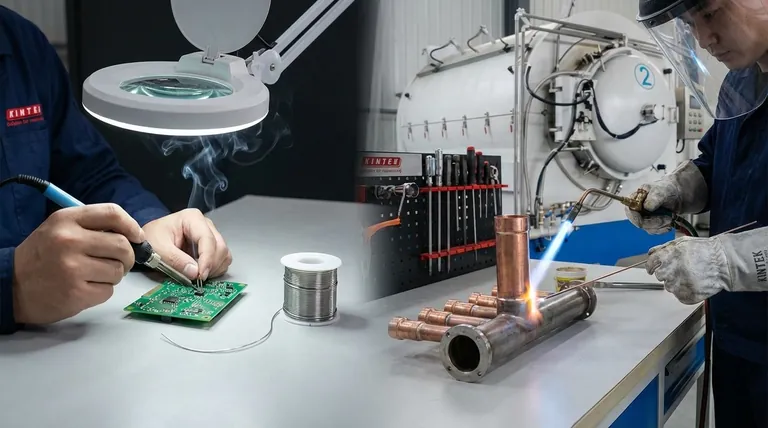从本质上讲,焊接和钎焊之间唯一的决定性区别在于温度。这两种工艺都使用填充材料连接金属,而不会熔化基本部件,但钎焊在高温(高于 450°C / 840°F)下进行,而焊接是在此阈值以下进行的低温工艺。这种基本的温度差异直接影响接头强度、材料兼容性和适用应用。
在焊接和钎焊之间进行选择是强度和敏感性之间的权衡。钎焊可产生异常坚固的结构性连接,而焊接的较低热量使其成为电子产品等精密、温度敏感部件唯一可行的选择。
决定性因素:温度和填充金属
这两种工艺的整个分类都取决于一个国际公认的温度。这个单一变量决定了所使用的填充金属类型以及由此产生的接头特性。
450°C (840°F) 阈值
这个特定温度是正式的分界线。任何使用熔点低于此点的填充金属的工艺都被归类为焊接。任何使用熔点高于此点的填充金属的工艺都被归类为钎焊。
焊接:低温工艺
焊接使用填充金属或焊料,通常是锡、铅、银或其他低熔点元素的合金。其目的通常是创建电连接,而不是高强度机械连接。
钎焊:高温工艺
钎焊使用熔点高得多的填充合金,通常含有银、铜、镍或铝。所涉及的更高热量通过称为毛细作用的过程促进填充物和贱金属之间形成更强的冶金结合。

为什么这种差异很重要:强度和应用
操作温度的显著差异为两组截然不同的问题创造了两种截然不同的工具。一种是为了强度而构建的,另一种是为了精密度。
接头强度:一个明确的区别
钎焊接头比焊接接头强度显著更高。一个正确钎焊的接头可以和它所连接的贱金属一样坚固,甚至更坚固。这使得它适用于必须承受显著应力或振动的结构应用。
相比之下,焊接接头相对较弱。其主要目的通常是粘合和导电性,而不是机械承载。
焊接的常见应用
焊接的低热量使其非常适合会因高温而损坏的组件。它最常见的用途是在电子产品中,用于将组件连接到印刷电路板 (PCB)。它还用于管道连接铜管以及彩色玻璃等装饰艺术。
钎焊的常见应用
钎焊的强度使其成为工业制造的主力。它广泛用于汽车工业的散热器和空调系统等部件、暖通空调以及工具和重型设备的部件连接。
了解权衡
选择方法不仅仅是选择最强的选项。钎焊所需的高温会带来您必须考虑的关键限制。
热损伤风险
焊接的主要优点也是钎焊的主要缺点:热量。钎焊的高温很容易损坏或变形薄的、精密的或经过预先热处理的基材,这使得该工艺不适用于敏感应用。
工艺复杂性和设备
焊接通常是一个更简单的过程,通常可以使用基本的烙铁或焊枪完成。钎焊需要更精确的温度控制和更强大的热源,这会增加复杂性和成本。
材料兼容性
虽然两者都可以连接异种金属,但钎焊通常更通用。高热量和专用填充合金允许在非常广泛的材料之间形成牢固的结合,例如钢与铜或碳化钨与钢。
为您的应用做出正确的选择
最终,选择完全取决于您特定项目的要求。
- 如果您的主要关注点是导电性或连接热敏组件:由于其低温应用,焊接是正确的选择。
- 如果您的主要关注点是结构部件的最大接头强度:钎焊更优越,可形成通常与所连接材料一样坚固的连接。
- 如果您的主要关注点是连接异种或高强度金属:钎焊为具有挑战性的材料组合提供了更坚固可靠的解决方案。
了解热量、强度和组件敏感性之间的这种基本权衡是为您的工作选择正确连接工艺的关键。
摘要表:
| 特点 | 焊接 | 钎焊 |
|---|---|---|
| 工艺温度 | 低于 450°C (840°F) | 高于 450°C (840°F) |
| 接头强度 | 较低(用于粘合/电气) | 高(结构性,与贱金属一样坚固) |
| 主要应用 | 电子产品、管道、精密组件 | 汽车、暖通空调、重型设备 |
| 热敏感性 | 适用于热敏部件 | 有损坏精密材料的风险 |
需要金属连接应用方面的专家建议吗?正确的设备对于实现完美的焊接或钎焊结果至关重要。KINTEK 专注于为您的所有热处理需求提供高性能实验室设备和耗材。我们的解决方案可确保对精密电子组件和坚固的工业钎焊进行精确的温度控制和可靠的性能。
让我们的专家帮助您选择满足您特定要求的理想设备。
立即联系我们,讨论 KINTEK 如何提升您实验室的能力和效率!
图解指南


























